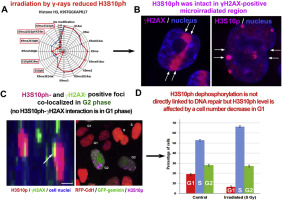Biochimie ( IF 3.9 ) Pub Date : 2018-08-08 , DOI: 10.1016/j.biochi.2018.07.029 Eva Bártová , Gabriela Lochmanová , Soňa Legartová , Jana Suchánková , Radek Fedr , Jana Krejčí , Zbyněk Zdráhal

|
Histone posttranslational modifications regulate diverse nuclear functions, including DNA repair. Here, we use mass spectrometry, western blotting, immunohistochemistry and advanced confocal microscopy in order to show radiation-specific changes in the histone signature. We studied wild-type mouse embryonic stem cells (mESCs) and mESCs with a depletion of histone deacetylase 1 (HDAC1), which plays a role in DNA repair. Irradiation by γ-rays increased the S139 phosphorylation of histone H2AX but reduced the level of the H3K9-R17 peptide, which contains S10 phosphorylation (H3S10ph). On an individual cellular level, H3S10ph was low in highly γH2AX-positive UV laser-induced DNA lesions, and this nuclear distribution pattern was not changed by HDAC1 depletion. Despite this fact, spontaneous γH2AX-positive DNA lesions colocalized with large H3S10ph-positive nuclear bodies that appear in the G2 phase of the cell cycle. Similarly, by FLIM-FRET analysis, we observed an interaction between H3S10ph and γH2AX in the G2 phase. However, this interaction was reduced when cells were exposed to γ-rays. A mutual link between H3S10ph and γH2AX was not observed in the G1 phase of the cell cycle. Together, our data show that despite the fact that H3S10ph is not directly involved in DNA repair, a decrease in H3S10 phosphorylation and weakened interaction between H3S10ph and γH2AX is a result of radiation-induced damage of the genome. In this case, γ-irradiation also decreased the number of cells in the G1 phase, characterized by no interaction between H3S10ph and γH2AX.
中文翻译:

γ射线辐照会降低H3S10磷酸化水平,并削弱H3S10磷酸化与γH2AX之间G2相依赖的相互作用
组蛋白翻译后修饰调节多种核功能,包括DNA修复。在这里,我们使用质谱,蛋白质印迹,免疫组织化学和高级共聚焦显微镜检查,以显示组蛋白特征的辐射特异性变化。我们研究了野生型小鼠胚胎干细胞(mESCs)和具有组蛋白脱乙酰基酶1(HDAC1)耗竭的mESCs,该组蛋白在DNA修复中发挥作用。γ射线辐照增加了组蛋白H2AX的S139磷酸化,但降低了含有S10磷酸化(H3S10ph)的H3K9-R17肽的水平。在单个细胞水平上,H3S10ph在高度γH2AX阳性的UV激光诱导的DNA损伤中较低,并且HDAC1耗竭不会改变这种核分布模式。尽管有这个事实,自发的γH2AX阳性DNA损伤与出现在细胞周期G2期的大型H3S10ph阳性核体共定位。同样,通过FLIM-FRET分析,我们观察到了G2相中H3S10ph和γH2AX之间的相互作用。但是,当细胞暴露于γ射线时,这种相互作用减少了。在细胞周期的G1期未观察到H3S10ph与γH2AX之间的相互联系。总之,我们的数据显示,尽管事实上H3S10ph不直接参与DNA修复,但是H3S10ph的磷酸化降低以及H3S10ph与γH2AX之间的相互作用减弱是辐射引起的基因组损伤的结果。在这种情况下,γ射线照射也减少了G1期的细胞数量,其特征是H3S10ph和γH2AX之间没有相互作用。同样,通过FLIM-FRET分析,我们观察到了G2相中H3S10ph和γH2AX之间的相互作用。但是,当细胞暴露于γ射线时,这种相互作用减少了。在细胞周期的G1期未观察到H3S10ph与γH2AX之间的相互联系。总之,我们的数据显示,尽管事实上H3S10ph不直接参与DNA修复,但是H3S10ph的磷酸化降低以及H3S10ph与γH2AX之间的相互作用减弱是辐射引起的基因组损伤的结果。在这种情况下,γ射线照射也减少了G1期的细胞数量,其特征是H3S10ph和γH2AX之间没有相互作用。同样,通过FLIM-FRET分析,我们观察到了G2相中H3S10ph和γH2AX之间的相互作用。但是,当细胞暴露于γ射线时,这种相互作用减少了。在细胞周期的G1期未观察到H3S10ph与γH2AX之间的相互联系。总之,我们的数据显示,尽管事实上H3S10ph不直接参与DNA修复,但是H3S10ph的磷酸化降低以及H3S10ph与γH2AX之间的相互作用减弱是辐射引起的基因组损伤的结果。在这种情况下,γ射线照射也减少了G1期的细胞数量,其特征是H3S10ph和γH2AX之间没有相互作用。在细胞周期的G1期未观察到H3S10ph与γH2AX之间的相互联系。总之,我们的数据显示,尽管事实上H3S10ph不直接参与DNA修复,但是H3S10ph的磷酸化降低以及H3S10ph与γH2AX之间的相互作用减弱是辐射引起的基因组损伤的结果。在这种情况下,γ射线照射也减少了G1期的细胞数量,其特征是H3S10ph和γH2AX之间没有相互作用。在细胞周期的G1期未观察到H3S10ph与γH2AX之间的相互联系。总之,我们的数据显示,尽管事实上H3S10ph不直接参与DNA修复,但H3S10ph的磷酸化降低和H3S10ph与γH2AX之间的相互作用减弱是辐射引起的基因组损伤的结果。在这种情况下,γ射线照射也减少了G1期的细胞数量,其特征是H3S10ph和γH2AX之间没有相互作用。



























 京公网安备 11010802027423号
京公网安备 11010802027423号